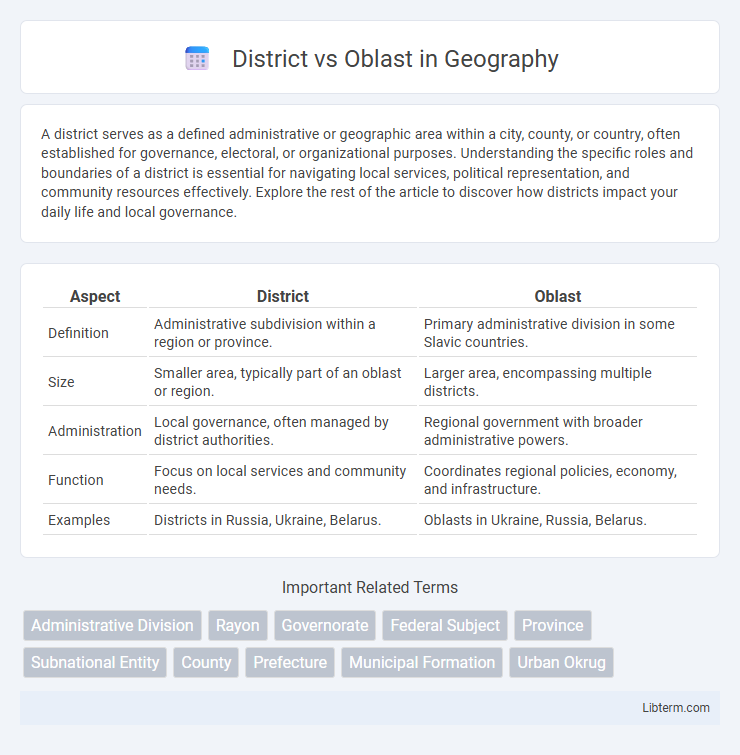A district serves as a defined administrative or geographic area within a city, county, or country, often established for governance, electoral, or organizational purposes. Understanding the specific roles and boundaries of a district is essential for navigating local services, political representation, and community resources effectively. Explore the rest of the article to discover how districts impact your daily life and local governance.
Table of Comparison
| Aspect | District | Oblast |
|---|---|---|
| Definition | Administrative subdivision within a region or province. | Primary administrative division in some Slavic countries. |
| Size | Smaller area, typically part of an oblast or region. | Larger area, encompassing multiple districts. |
| Administration | Local governance, often managed by district authorities. | Regional government with broader administrative powers. |
| Function | Focus on local services and community needs. | Coordinates regional policies, economy, and infrastructure. |
| Examples | Districts in Russia, Ukraine, Belarus. | Oblasts in Ukraine, Russia, Belarus. |
Introduction to Districts and Oblasts
Districts and oblasts represent distinct administrative divisions used in several countries, particularly in Eastern Europe and Russia. A district typically refers to a smaller administrative unit within an oblast or region, serving local governance and administrative functions. Oblasts are larger territorial entities, similar to provinces or states, encompassing multiple districts and holding broader governmental authority and administrative responsibilities.
Definition of a District
A district is an administrative division within a country, typically serving as a subunit of a larger region such as an oblast or province, and is responsible for local governance, public services, and law enforcement. Districts vary in size and population but function as key units in the organization of administrative management, often encompassing multiple towns or municipalities. Unlike an oblast, which is a major territorial and administrative region similar to a state or province, a district operates at a lower hierarchical level, focusing on localized administrative tasks and community development.
Definition of an Oblast
An oblast is a primary administrative division used in several Slavic countries, notably Russia and Ukraine, characterized by a larger territorial scope and greater autonomy compared to a district. It functions as a significant regional unit with its own government structure, managing diverse local affairs such as education, transportation, and economic development. In contrast, a district is a smaller statistical or administrative unit within an oblast, responsible for more localized governance and community services.
Historical Background of Districts and Oblasts
Districts and oblasts originated from different administrative traditions reflecting varying scales of governance; oblasts emerged in the Russian Empire and Soviet Union as large regional divisions intended for managing vast territories, while districts, or raions, were established as smaller units within oblasts to facilitate localized administration. The historical development of oblasts involved centralizing authority over extensive areas with diverse populations, whereas districts served to streamline governance and economic planning at a more granular level. This hierarchical structure allowed for efficient political control and resource distribution across the expansive territories of Eastern Europe and Central Asia.
Administrative Structure: District vs. Oblast
Districts function as lower-level administrative units within an oblast, providing localized governance and management of municipal services. Oblasts represent larger regional entities with broader administrative authority, overseeing multiple districts and coordinating regional policies, economic planning, and infrastructure development. The hierarchical structure places districts under the jurisdiction of oblast governments, ensuring administrative efficiency and adherence to regional regulations.
Governance and Local Authority
Districts serve as administrative subdivisions within oblasts, offering more localized governance and direct public service management. Oblasts function as larger regional authorities with broader legislative powers, fiscal budgets, and coordination responsibilities over multiple districts. The division of authority ensures oblasts oversee strategic development and policy implementation while districts manage community-level administration and local enforcement.
Geographical Differences and Coverage
A district typically represents a smaller administrative division within a country, often encompassing towns or cities and their surrounding rural areas, making it more localized in geographic coverage. An oblast is a larger administrative region, similar to a province or state, covering extensive territories that include multiple districts, cities, and diverse geographic features such as plains, rivers, and mountains. The geographic difference lies in scale, with oblasts providing broader regional governance, while districts focus on more specific local administration.
Examples of Districts and Oblasts Worldwide
Districts and oblasts serve as administrative divisions in different countries, with districts often being smaller units within regions or provinces, while oblasts are larger territorial entities primarily found in Slavic countries like Russia and Ukraine. For example, the Los Angeles County is a well-known district in the United States, characterized by localized governance and administrative functions. In contrast, Moscow Oblast in Russia represents a significant federal subject with a broad administrative scope, encompassing multiple cities and smaller districts.
Key Functions and Responsibilities
Districts primarily manage local administration, including public services, community development, and local law enforcement, operating under the jurisdiction of regional authorities. Oblasts function as larger administrative divisions responsible for regional governance, economic planning, infrastructure development, and coordination of inter-district policies. Oblasts also oversee healthcare, education systems, and transport networks within their territories, providing strategic direction and resource allocation to subordinate districts.
Conclusion: Comparative Analysis
Districts serve as smaller administrative units within oblasts, which function as larger regional divisions, making oblasts more significant in terms of governance scope and resource allocation. The distinction lies in the hierarchical scale and administrative authority, with oblasts overseeing multiple districts, thereby enabling broader regional planning and development strategies. Understanding this structural difference clarifies the varying administrative responsibilities and jurisdictional impact between districts and oblasts.
District Infographic

 libterm.com
libterm.com